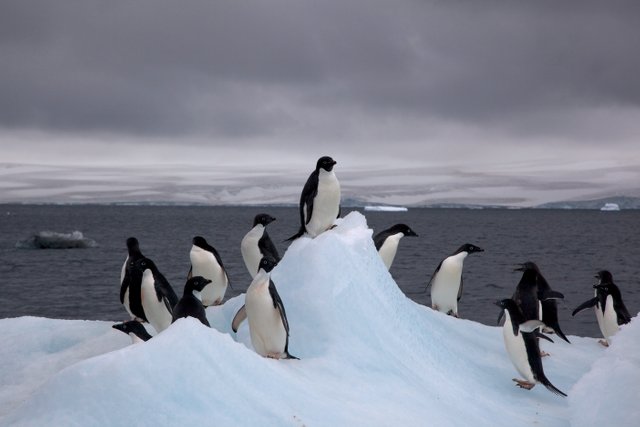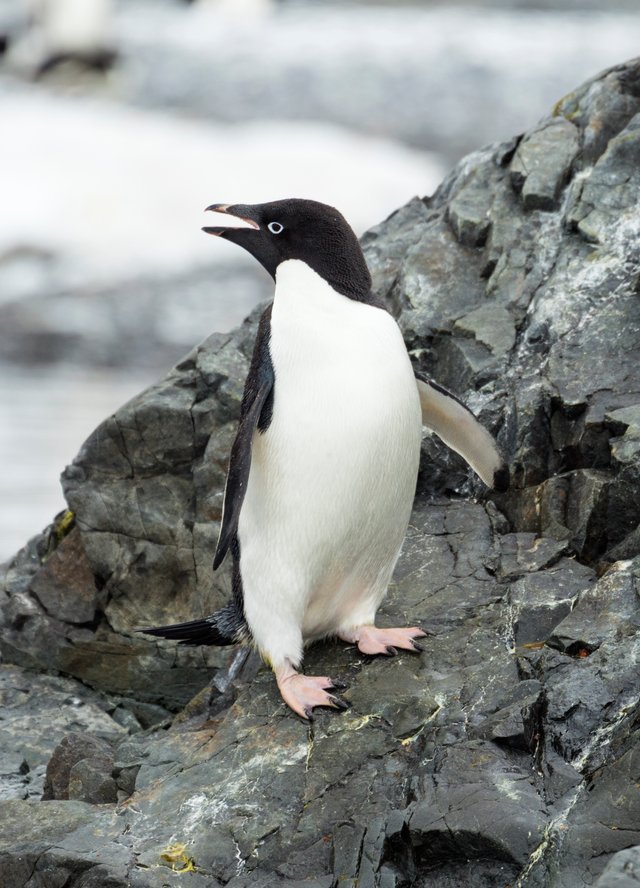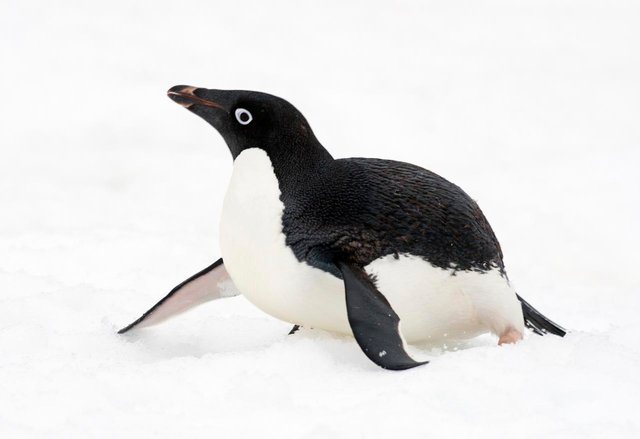1.5 million new Adélie penguins (Pygoscelis adeliae) was just found on the remote Danger Islands!
We often like to think that we humans have explored most parts of the world and have a good knowledge about where we find the different animals species, but every now and then we make huge discoveries that show us just how little we know.
Back in 2014, images from a NASA satellite shows something really interesting on Danger Islands; guano/poo stains from penguins. This is obviously a clear indication of penguins are living on the island, and a research team from several different universities travelled down to these Antarctic island to investigate further.
What the found when they arrived at the islands were huge amounts of Adélie penguins (Pygoscelis adeliae)! The researchers were amazed by the number of penguins they saw, and quickly figured out that it would be impossible to estimate the number from the ground.

Adélie penguins on an iceberg. Image by Jason Auch, posted with the Creative Commons Attribution 2.0 Generic license.
This lead to drones being launched into the air to do an aerial survey of the island to collect data. This data could then be processed to estimate the population size and health of the population.
Danger Islands are a group of islands found on the Antarctic Peninsula, close to Joinville Island. When it was discovered in 1842, it got its name because it appeared among heavy fragments or ice, and the ship did not see the islands until they were nearly upon them. As you can probably guess by now - this is not an island that is very easy to travel to, so this is why this penguin colony had been undiscovered for such a long time.
Adélie penguins
Adélie penguins are as pretty common species of penguins, and are found along the entire Antarctic coast. Estimations from 2014 estimated that there are 3.8 million breeding pairs of this penguin, spread out over 251 colonies (but this obviously needs updating now).

Image by Andrew Shiva, posted with the Creative Commons Attribution-Share Alike 4.0 International license.
These penguins mostly eat krill, jellyfish and squid, and stay away from bigger prey such as fish. They are still considered Least Concern by the IUCN Red List due to their population numbers and the amount of different colonies, but they have been considered to be a good indicator of how climate change affect the Antarctic regions. The newly discovered population on Danger Islands will further their claim as being a sustainably and healthy species, so luckily we won’t see them go extinct anytime soon.
The discoveries from Danger Islands
Once the researchers returned from Danger Islands, the real work began. All the data had to be analyzed, and once that was done, the researchers concluded with the fact that this island hosts 751,527 breeding pairs of Adélie penguins, or just above 1.5 million individuals. This is among the biggest Adélie penguin colonies in the entire world, so it is a big discovery.
An interesting observation is that the scientists to not believe that penguins to have been affected by climate change as much as the other colonies, due to the remote areas they live in. This makes the colony a perfect candidate for further study, since we now have a benchmark number “pre-population loss” to compare against.
Differences on the same island
The researchers also found the western colonies to be somewhat different from the eastern colonies, and now wish to keep studying them in order to find out why they appear different from each other despite living on the same island. They already believe it might have to do with either ice conditions or food availability, but don’t really know any details just yet.

Image by Christopher Michel, posted with the Creative Commons Attribution 2.0 Generic license.
The western part of the island has also been experiencing a bit of warming in the last years, so another theory is that this could be the reason for the difference.
Thanks for reading
I hope you enjoyed learning some more about the Adélie penguins and this new discovery. If you want to read more about these guys, check out this post from 5 months ago about the same species of penguin, but be warned, that post does not bring as good news.
About @valth
Hey, I'm @valth - the author of this post. I love to write about nature, biology, animals, nature conservation, ecology and other related branches of science, and I occasionally write about my life, about Steem or about random stuff as well. I'm trying my best to write at least one post every day, so make sure to give me a follow if you enjoy my content and want to see more of it.
Join the @valth community!
I love nothing more than to engage with my readers, so please join the @valth community in the comment section. You will definitely find more information about the topic, personal experiences, questions, and even opposing views down there, so don't miss out on learning more.
I always reward users who post good comments, so please take the opportunity to share your views and get a small upvote in exchange for it.
You received a 80.0% upvote since you are a member of geopolis and wrote in the category of "ecology".
To read more about us and what we do, click here.
https://steemit.com/geopolis/@geopolis/geopolis-the-community-for-global-sciences-update-4
Thank you :)
Being A SteemStem Member
Thanks, @steemstem!
@valth this is really promising news especially when you consider your last post on the impact the climatic change and the distances they have to travel. Perhaps if they started a relocation program to some of the islands closer to viable food sources it might help bolster numbers. However i suspect its ingrained into their DNA that these islands are “home” for them.
You are quite correct, we may have explored a lot but we have much much more to discover, and most likely even new discoveries from right under our noses. When we get too presumptive, we let the science slip and end up missing out on so much!!
It is nice to see science and technology melding well in this case:- who would have thought that you would have been able to count the number of penguins on a remote island by drones 10-15 years ago!!
Yeah, it is absolutely great news when we consider how several other populations are having huge problems these days.
Your suggestion about relocation problems are interesting. I know many species of birds have this preprogrammed home destination when they travel, but I honestly have no idea if this applies to the Adélie penguins.
That's true. Drones are turning out to be really useful these days, and I think they will just keep on increasing their usefulness as the technology increases their range, image resolution etc.
Drones are a blessing and a curse all at once. In this instance they are incredible since they can maneuver around easier that a person could walking on the island. In other instances, such as while I was in Peru, people use them to get too close to the wild life which stresses them out. I personally would love to go out to areas that aren't easy to access and check them out with drones while being mindful of the local animals.
I'd be surprised if the variation on the western part of the island was from the warming alone, but it's a neat theory.
Btw, I noticed a couple mistakes in this post... it's not my intention to put it on blast in the comments, but I really don't have anywhere else I could tell you about it. But just so you are aware...
if you want, in the future I can tell you elsewhere, in an email or something so that it isn't in the comments section. The only reason I even bring it up is because of how often you refer to previous posts. Either way, Great post!
You make some good points about the drones. They can be incredible, but we need to be careful about how we use them, because I can imagine how scary it will be if they get too close to wildlife.
I'm actually really excited to see if they are able to find good data to support a theory about this. It is most likely several reasons that adds up to the net effect, but we'll see :)
Thanks for pointing out the typos! I try my best to get rid of them before I publish the post, but I usually tend to miss one or two. It's fine that you point it out in the comment section, I actually do appreciate it, because now I have a chance to edit it before the post gets too old.
This gives me a good feeling that there are still places around the world with good vegetation and not disturbed by humans or other global problems (directly). But as you mentioned, I'm not sure if this can be a good thing for a global balance. If just one species alone grow in numbers, that's not a good sign either.
The colonies may not be in danger of extinction but I feel the species on which they feed upon should be taken into consideration and their numbers should be keenly watched. Well, not now but in the long run Adélie penguins may run out of krill, jellyfish, and squid to feed upon. 😛
Sadly I don't think they will be unaffected by the pollution and climate change for very long, because this tends to reach all places, it just takes a lot longer to get to the Antarctic.
That's a very good point! Some research claims that they used to eat a lot more fish 20-30 years ago, but changes their diet to krill, squid and jellyfish once humans begun to fish a lot in the area, and the populations of their prey fish declined.
So humans are someway being responsible for all the disasters happening around the world. That's really sad. 😏
Yeah, absolutely. It's very sad, but it is just the reality :/
Amazing discovery...
1.5 million penguins and we never knew about it!!!that indeed is an indicator of the lack of our knowledge of the great sphere we call home..
Yeah, exactly! There are so many things we have left to learn ;)
Great news indeed to discover 1.5 million penguins in danger land. Still a lot of facts about wild life and marine life is unknown to us. Hopefully we have some more good news in near future. Thanks for sharing:) @valth
Yeah, it is for sure a great discovery! It would be really cool if we found more hidden animal populations like this one in the future ;)
Today, I learned about a new species of animals from your post. . I know about penguins and I like penguins.This is the first time I heard the name of such a creature. But they often look like penguins. . @valth Thank you so much for sharing such a wonderful educational post
I'm glad you learned something new from the post :)
It is amazing that they were able to count the penguin population down to single digit! How did they do that??
They just take a lot of pictures with the drones, then head back to a computer to do the count. There's nothing to it except for counting I guess, just a lot of time :P
Thanks, God there is no band news about Adélie penguins😊😊.
and MASHALLAH they are huge in numbers 751,527 breeding pairs of Adélie penguins, 1.5 million individuals roundabout 👌.At least there is no fear for them to go extinct.One of your best post indeed @valth
Thanks.
No, there's no immediate fear of them going extinct right now :) But sadly there are other species of penguins that are in more danger.